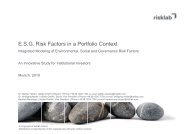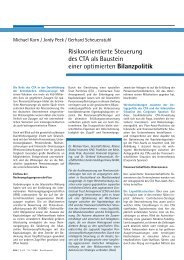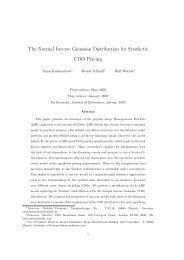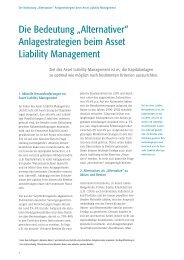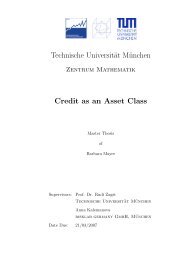Technical University Munich Commodities as an Asset Class - risklab
Technical University Munich Commodities as an Asset Class - risklab
Technical University Munich Commodities as an Asset Class - risklab
You also want an ePaper? Increase the reach of your titles
YUMPU automatically turns print PDFs into web optimized ePapers that Google loves.
2.3 Trading <strong>Commodities</strong><br />
tives markets in other <strong>as</strong>set cl<strong>as</strong>ses. They provide liquidity improvement, speed of<br />
execution <strong>an</strong>d structural flexibility. Nowadays, their role is becoming more complex<br />
<strong>an</strong>d interdisciplinary. They underst<strong>an</strong>d themselves <strong>as</strong> all fin<strong>an</strong>ce service provider<br />
to feed their clients with structured products. Their interaction with the l<strong>as</strong>t big<br />
particip<strong>an</strong>t group of commodities markets, the investors, is growing strongly.<br />
Investors trade commodities <strong>as</strong> a separate <strong>as</strong>set cl<strong>as</strong>s <strong>an</strong>d care about their portfolio<br />
risk <strong>an</strong>d return profile to maximize their revenues. For producers they are essential<br />
<strong>as</strong> risk takers whereupon the oldest theory of how commodity prices are build up,<br />
the so-called theory of normal backwardation, 39 is b<strong>as</strong>ed on. Investors never will<br />
hold commodities until delivery. C<strong>as</strong>h settlement or selling before maturity is done.<br />
Investors are necessary for fair price formation, i.e. fin<strong>an</strong>cial markets c<strong>an</strong> only<br />
be efficient when its members reach a critical m<strong>as</strong>s. Different articles 40 , which<br />
<strong>an</strong>alyze the return development of actively m<strong>an</strong>aged commodity portfolios, mention,<br />
that their pure alpha decre<strong>as</strong>ed over time. This pattern indicates that fin<strong>an</strong>cial<br />
markets become more efficient <strong>an</strong>d arbitrage opportunities are disabled just because<br />
of liquidity <strong>an</strong>d trading volume.<br />
2.3 Trading <strong>Commodities</strong><br />
To cover all the different needs of the market particip<strong>an</strong>ts, a r<strong>an</strong>ge of different<br />
fin<strong>an</strong>cial products enabling both, hedging <strong>an</strong>d speculation, were developed. Unfortunately,<br />
some investors might feel lost in the forest of opportunities. Therefore,<br />
they should first develop a set of requirements that meet their individual investment<br />
needs. Then, they should search <strong>an</strong>d screen <strong>an</strong>d just finally select what will meet<br />
their individual objectives. In the following section the most common commodity<br />
investment vehicles <strong>an</strong>d related products are introduced. For it, Figure 2.16 shall<br />
give a first overview. There are two major ways of investing into commodities: the<br />
direct <strong>an</strong>d the indirect over stocks.<br />
Our main focus lies on the direct way to get commodity exposure.<br />
To be very<br />
precise, it is divided into the direct commodity investment over fin<strong>an</strong>cial products<br />
<strong>an</strong>d the direct commodity investment into the commodity product. But we <strong>as</strong>sume<br />
that no investor is actually interested in camping oil barrels or corn bags in his<br />
b<strong>as</strong>ement, we will focus on the direct commodity investment over fin<strong>an</strong>cial products<br />
without physical delivery. The b<strong>as</strong>ic products are described in Section 2.3.1<br />
39 We will examine the theory of normal backwardation in Section 3.1.<br />
40 See e.g. [Edwards Liew 1999] or [Fung Hiesh 1997].<br />
31



